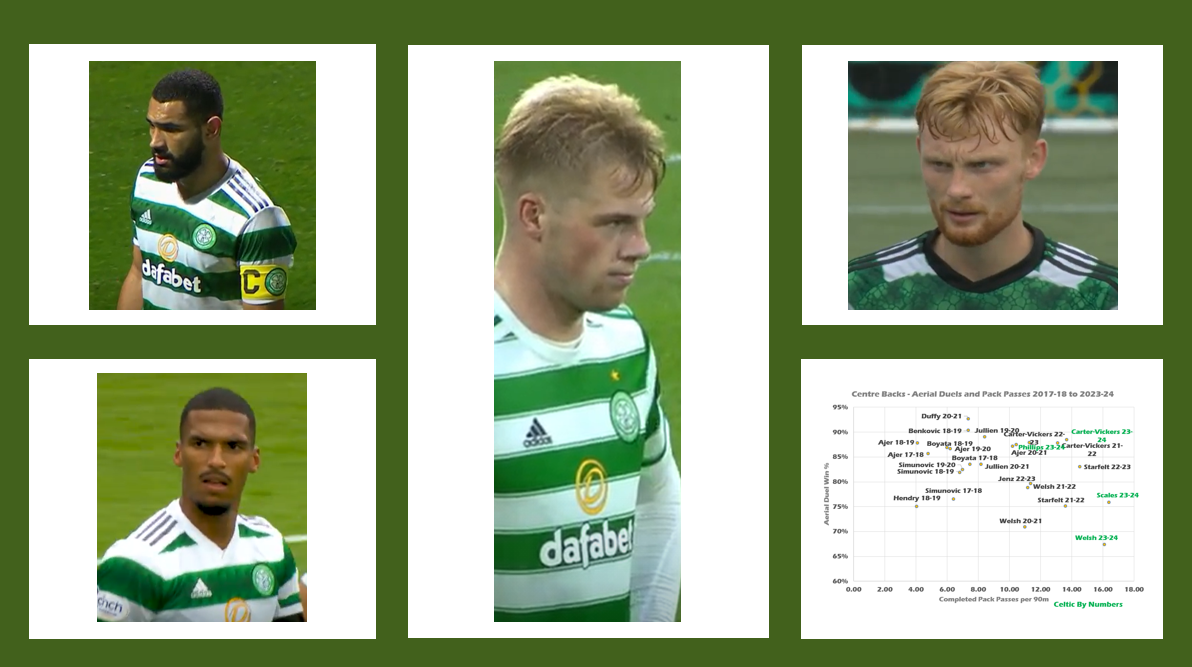I wrote extensively on Liam Scales in the Celtic Way last week. They have an incredible offer of only £1 a month for six months. The other writers are really strong, so I recommend it.
It is always a challenge to come up with a compelling view that might tell a story that accurately reflects a player’s overall worth to the team.
I picked the following view up from a data vendor sight that is plugging their toolset on X. They are a bit “clickbaity” so won’t mention them but will happily steal their idea. Thems the breaks! (Ach, they are called “Data MB”).
Back to Scales and centre-backs.
Assessing defenders, like goalkeepers, is not as easy as attackers as I have mentioned many times. Also, to communicate, we tend to be reductive in the data presented to not confuse and overwhelm.
The following maps two facets – aerial duel win percentage and average pack pass score. Passin’ and heidin’. The reason I found this interesting is that intuitively we think of centre-backs as either being big, strong, and commanding, or smaller and good with the ball.
Absolutely an oversimplification but what do recent centre-backs look like in terms of having a foot in both those camps?
Aerial Strength + Ball Progression
This covers those with over 900 minutes in a season since 2017-18.

The most interesting aspect of this view is not the individual players so much as what it tells us about how the style of play has evolved over the last six seasons.
When Christopher Julien was at his peak, I was waxing lyrically on here about this aerially dominant eagle who also passed the ball forward through the lines! What sorcery!
Many of us considered Kristopher Ajer a ball-playing centre-back during his time.
But even Matt Phillips played more line-breaking pack passes than those.
Indeed, the far right of the graph, indicating a high volume of pack passes belongs to centre-backs from the last three seasons.
Brendan Rodgers-ball mark 2 is indeed more like Ange-ball than Rodgers-ball mark 1!
At least as regards how the defenders play. Stephen Welsh was a revelation in 2020-21 under Neil Lennon when he broke the 10 pack passes per match mark.
Now Liam Scales is averaging over 16.
The current centre-backs are highlighted in green and whilst both Scales and Welsh are adept at moving the ball forwards, they are amongst the lowest in aerial duel success. This view highlights neatly why buying Moritz Jenzm made no sense when you had Welsh in the squad.
We can see top top-right is where Cameron Carter-Vickers has his domain and is very much “the best of both worlds”. Aerially dominant and capable of moving the ball forward.
This is not earth-shattering, but I wanted to share a view that can help to profile candidates and remove some of the data noise, focusing on two core competencies.
But it also tells us that team style is very important, and a player may profile a certain way because of instruction as opposed to simply capabilities.

Thanks as ever for your article.
A couple of thoughts. Firstly, taking the passes out of the equation is the poor aerial duel wins causing us to have such a terrible defensive/points dropped record?
Secondly, with the pack passing is there a metric (is that the word) for speed of pass packing? I ask this having listened to the 20 minutes Tims mentioning Scales slow passing (I can’t claim it’s my original thought) and also Derek McInnes talking about how he was happy to allow/wanted balls to be playing to particular players. I’m thinking Angeball -getting the ball forward before teams have time to get back and get organised.
Thank you
It is difficult to pinpoint a hard line between losing aerial duels and opposition chance creation unless you see it contributing to an individual goal. What concerns me is the secondary impacts – ie rather than winning the ball cleanly and it being away from danger, not cleanly winning such duels leads to corners, throws etc that then create secondary issues.
Speed of pass is measured but isn’t available from any of the usual vendors for free. Someone passed me some data earlier in the season that showed Scales is a fraction of a second slower in releasing the ball – ie 1.5 seconds as opposed to 1.46 from CCV – but multiply the impacts of this across eg 75 passes each per 90m
Poor Liam! Would appear we all believe him to be the best of a bad bunch. The guy has progressed I believe. Unfortunately, we need a bit more than big Scales can offer. I thought the same of Stephen Welsh as he broke through.
Bigger puzzle is the new defenders lack of action. How would you opine given no stats?
Enjoyed the article, cheers.
Just for a laugh, I’ll once again highlight, what a great defender this shows Starfelt to be ?.
Well he improved in season 2
Another point is Celtic could have saved 4.5m and just played Scales
Neither are up to CCV standard unfortunately
Is it possible to demarcate game play and time wastage through our frustrating use of backpass to CBs even when 2 nil down? Are the contemporary stats symptomatic of our failure to creatively press forward through packed midfields and defensive lines?
I would love to have the time and capacity to store metadata about every event – location, context etc but that is simply unfeasible without an AI / geospatial tool to track player movements.
Breaking lines thru passing is easier thanks to packing and i regularly write on this on a comparative basis
thanks